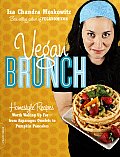
It really only makes sense to migrate for food if it's 10,000 BC. Or if you're a cookbook author.
NYC might be the food capital of the world, but I chose to leave for Portland because of the fresh and local produce (where else has anyone heard of a marionberry that wasn't a — groan — crack-smoking mayor?) and the vegan friendliness (Lebanese restaurants with the word 'vegan' on the menu? GTFO. Kibbeh here I come). But it wasn't just the actual food that brought me here, it was all that came with it. My tiny Brooklyn kitchen was closing in on me... literally. The walls where my pots and pans hung were turning into an Indiana Jones booby trap. The ceiling was sprinkling little bits of plaster over every surface like so much confectioner's sugar. My spices were battling it out with my cleaning supplies for space. It wasn't pretty.
In Portland a cook can stretch out, spin around without sinking the souffle, even lean against the counter; not because space was so tight that you had to but because, goddamit, you wanted to!
 And then there's procurement. One can argue that the Union Square Farmer's market has some of the best and most interesting produce the world has to offer, and one might be right. But who besides your trust-fund co-worker and 87-year-old rent-control aunt live anywhere near it? I love to lug a hubbard squash around on the subway as much as the next girl or champion weightlifter, but come on. Enter Portland with its bike-friendly thoroughfares, myriad food co-ops and neighborhood farmer's markets. And if the all-vegan grocery store isn't anywhere nearby, well, even Fred fucking Meyer has an organic produce aisle. They seem to be lacking in any sort of Hannukah paraphernalia come the holidays, but cultural diversity is maybe an issue for another day.
And then there's procurement. One can argue that the Union Square Farmer's market has some of the best and most interesting produce the world has to offer, and one might be right. But who besides your trust-fund co-worker and 87-year-old rent-control aunt live anywhere near it? I love to lug a hubbard squash around on the subway as much as the next girl or champion weightlifter, but come on. Enter Portland with its bike-friendly thoroughfares, myriad food co-ops and neighborhood farmer's markets. And if the all-vegan grocery store isn't anywhere nearby, well, even Fred fucking Meyer has an organic produce aisle. They seem to be lacking in any sort of Hannukah paraphernalia come the holidays, but cultural diversity is maybe an issue for another day.
And so when people ask me how I can live without NY pizza, I shrug and say Portland pizza is perfectly fine, and sometimes even just plain perfect. The Ethiopian food is even better. And, of course, the food carts. There are a couple of things I won't touch here, like Chinese food, and I've yet to find a falafel I love (I've been assured they're out there,) but I eat those rarely enough that a fix every few months when I visit NY is good enough for me. But the one thing that I miss, that I really can't get here, that leaves a tire shaped hole in my soul, is bagels. Crusty, puffy, doughy, chewy bagels. Lightly toasted, spackled-on tofu cream cheese, walking down the street eating it — nothing says morning like a NYC bagel. And I know what you're going to say, you're going to rattle off a short list of Jew-y sounding names and tell me that they are NY style bagels. And I'll grant you that some of them come close, but I don't think our tastebuds recognize "close," it's either/or with those guys.
There's plenty of speculation as to why it's so hard to get NYC bagels right outside the borders of the tri-state area. Rumors of bakeries in Arizona that import NYC tap water abound, but I think if it can be done in China it can be done anywhere. Maybe you just have to channel your inner New York Jew. So put on the Fiddler on the Roof soundtrack and kvetch to your local Fred Meyer manager that they need to carry dreidels, then try out this recipe.
1 1/2 cups lukewarm water
One 1/4 oz packet dry active yeast
4 cups all purpose flour
2 tablespoons vital wheat gluten
2 teaspoons salt
3 tablespoons sugar
Vegetable oil for the bowl
Salt for the boiling water (2 teaspoons or so)
Sesame or poppy seeds
 Dissolve one tablespoon of the sugar in the lukewarm water, then add the yeast. In a large mixing bowl mix together the other ingredients. Add the water/yeast and knead for a good 10 minutes or so. The dough should be neither dry nor wet but nicely tacky. A mixer with a dough hook works great here. Place in an oiled mixing bowl and cover with a damp cloth (or saran wrap) and let sit for an hour or so. It won't rise a lot but it should be nicely springy.
Dissolve one tablespoon of the sugar in the lukewarm water, then add the yeast. In a large mixing bowl mix together the other ingredients. Add the water/yeast and knead for a good 10 minutes or so. The dough should be neither dry nor wet but nicely tacky. A mixer with a dough hook works great here. Place in an oiled mixing bowl and cover with a damp cloth (or saran wrap) and let sit for an hour or so. It won't rise a lot but it should be nicely springy.
Now we're going to form and boil the bagels. Put a large pot of salted water on to boil and preheat the oven to 425 F. Turn dough out onto a dry surface and cut into 12 equal pieces. Roll each piece into a ball, then tuck the dough under until you poke a hole through the center. Work the hole until it's roughly half-dollar sized (about 3/4 of an inch.) Place on a baking sheet covered with parchment and cover with a damp kitchen towel. Once the water is boiling, reduce to a gentle simmer and add three of the bagels ? they should bob up to the surface in a few seconds, if they don't nudge them with a spoon until they unstick. Simmer for one minute, then flip them over and simmer for another minute. Remove the bagels using a slotted spoon and place back on the baking sheet. Repeat until all you bagels are boiled. Spread seeds, if using, out on a plate. Press each side into the seeds, then place in the oven. Bake for 18 to 20 minutes, until nice and amber-browny, then remove and let sit for 30 minutes. The bagels are now ready.